Fardh al-Qanoon: Creating a map
I’ve previously talked a bit about designing a Fardh al-Qanoon simulation and what the elements of the conflict’s simulation would be. Today I discuss the map, an essential component of any manual simulation.
In Professor Philip Sabin’s Conflict Simulation course, we had to submit an initial draft of our game map well over a month ago. Dr. Sabin, who has designed many simulations, gave us each detailed comments about our initial submissions. I’ll admit, I thought my first draft was rather clever and would make a decent foundation to work from. The passage of time and hours of revision have given me the clarity to realize how silly I was.
The initial map
(Note that many labels and game-related values have not yet been inserted. This is a very rough first draft.)
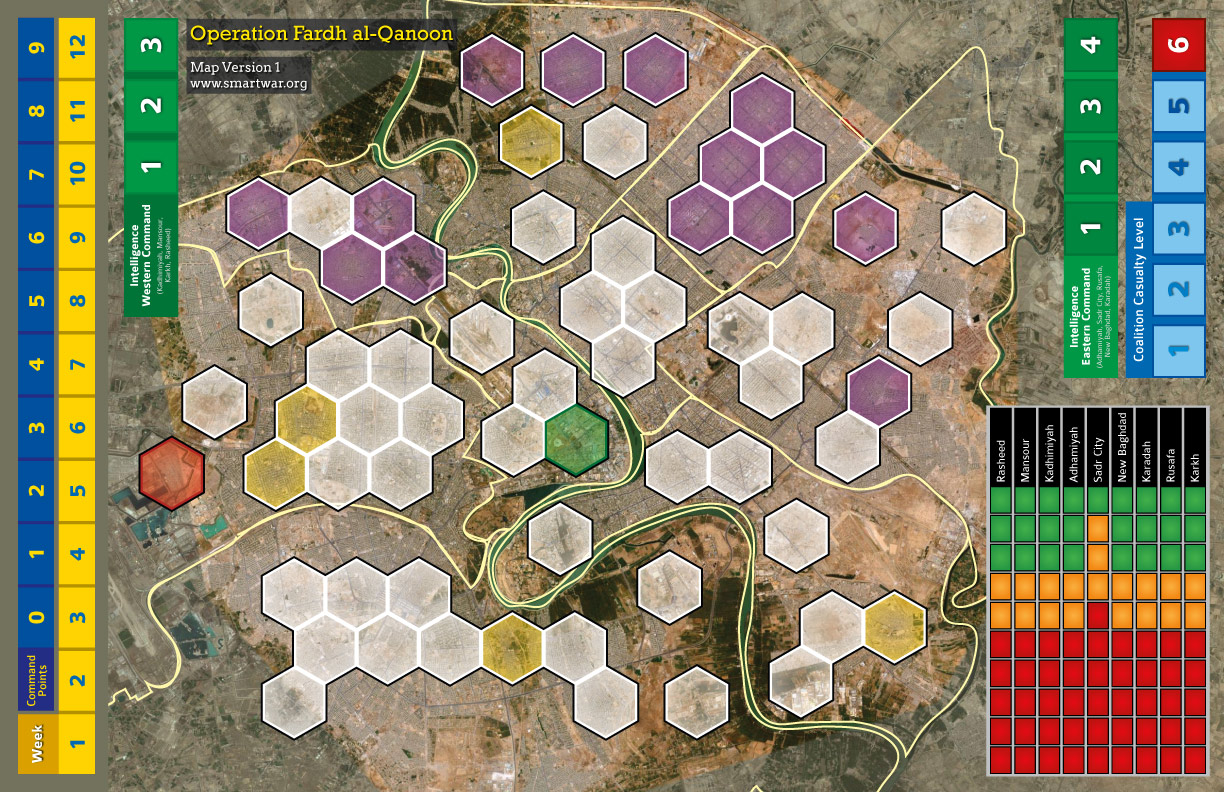
I believe one of Dr. Sabin’s initial remarks was to describe the map as “science fictiony,” which in retrospect was being too kind. The miasma of colors and shapes do serve specific purposes, but those purposes could be achieved in much subtler, less seizure-inducing ways.
I went with hex-shaped boxes overlaid on a satellite map of Baghdad to represent neighborhoods, since there is such a wide variety of neighborhood shapes and sizes. Some districts have been broken up into more neighborhoods than are listed in this document (pdf), while other districts have had neighborhoods of similar ethnic makeup combined.
As you can see, this version of the map distinguishes between Shia-dominated, Sunni-dominated, and mixed neighborhoods (purple = Shia, yellow = Sunni, white = mixed). The green hex represents none other than the Green Zone, while the red hex represents the FOB at Baghdad International Airport.
There are many tracks littering the map, but the one of primal importance is the collection of tracks on the bottom right. Since this simulation is about a counterinsurgency operation, the most important metric is how much support the two opposing players (representing the Coalition and the Shia faction of Baghdad) can garner in each district.
As I made progress on the rules and reflected on Dr. Sabin’s comments, I ended up making quite a few changes to the map. The most recent draft of Version 2 drastically changes almost every element.
Map Version 2
(Note: once again, many labels and game-related values have not been added yet.)

As you can see, the timescale has been changed from weeks to months, and the game now covers 10 months rather than 12 weeks. This reflects a change in the “turn” mechanism; initially, I planned for the Coalition player’s use of “Command Points” (since done away with) to determine the passage of time. Instead, each round (lasting one month) will have set phases during which each player has a chance to perform their specific tasks.
The number of neighborhoods has been drastically reduced and now stands at 25, with 12 in the western districts and 13 in the eastern. Many districts have 2 or 3 neighborhoods, while Mansour and Rashid each have 4. I felt this was a fairly important disparity to include because while the districts with 4 neighborhoods gives the Shia player more “space” to hide and maneuver, they have to balance that opportunity against maintaining their influence in districts with fewer neighborhoods, where the population density gives the Coalition the chance to make a big impact.
The overall concept with the district influence tracks remains the same. There are 7 “levels” of support in each district, and players reap benefits from building up support depending on which faction they are playing. The “Intelligence” tracks have been combined into one, and two separate counters will track western and eastern district intelligence (I don’t know why it didn’t occur to me to do this in the first place; two intelligence tracks was such a waste of space).
Two new tracks are the Coalition-Sunni Relation track, which is exactly what it sounds like and has the effect of changing what kind of Sunni actions take place during the game (better relations means fewer terrorist attacks and sectarian operations, and more community-building efforts and cooperation with Coalition forces). The Sunni Empowerment track determines how many Sunni actions take place each month, and this track can be negatively affected by the Shia player executing sectarian operations to drive Sunnis out of their neighborhoods.
The last new element is a pair of mission hex sections, one for western and one for eastern Baghdad. Now that I’m using “phases” during rounds, the Coalition will have to decide how to use their forces in a given month by assigning them different missions at the beginning. Having a high level of support in a district, however, gives the Coalition the flexibility to change missions on the fly. If, for example, the Coalition player sees that the Mahdi Army is making a play for a district and massing militia forces, he can reassign units in the “Build” hex to “Raid” and attack the Mahdi Army.
Rules, rules, rules (and counters)
Of course, none of this matters without a solid system of rules, and there are still map counters to consider. I’ll be done with a draft of the rules and the counter designs by Thursday, since that’s when all of this needs to be submitted for class. Look forward to those later this week.

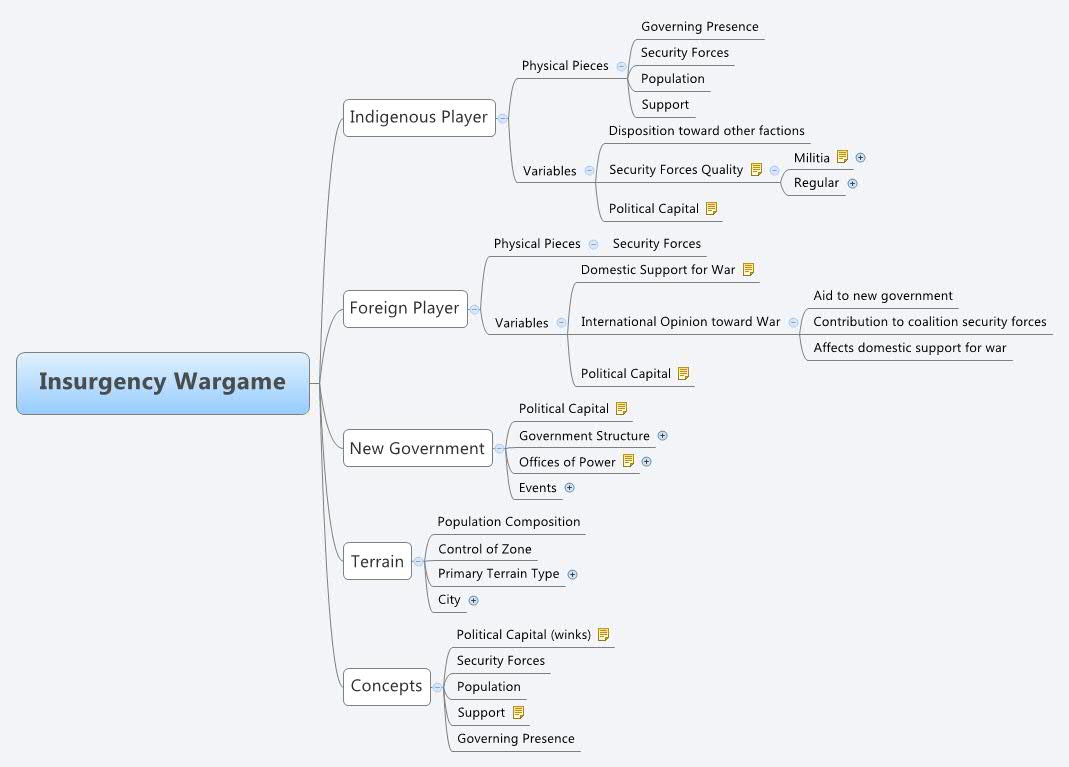

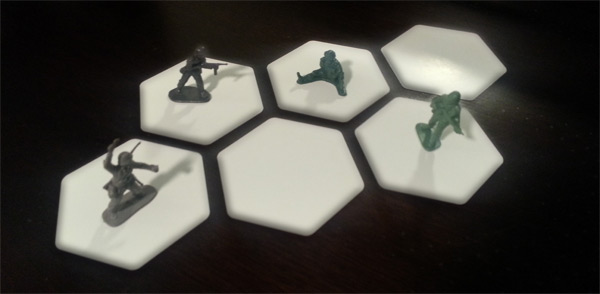
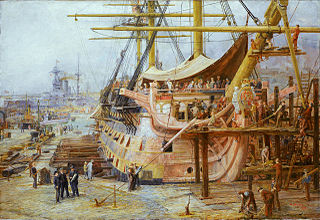


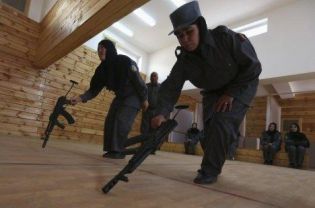


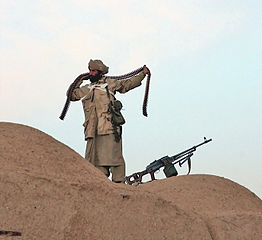
A great post–I’ve been enjoying the series, and we’ve given it a shout-out at PAXsims (http://paxsims.wordpress.com/2012/01/11/simulations-miscellany-10-january-2012/). We’ll look forward to seeing the final result. Do you have playtesters?
Professor Sabin has the students organized into four teams, and team members will be playtesting each other’s simulations. Another student on my team is simulating the terrorist attack in Mumbai as a solo game, so it will be interesting to see another scenario with limited intelligence.